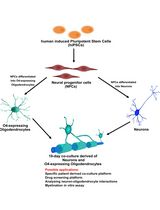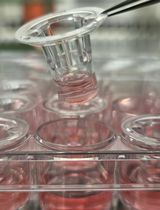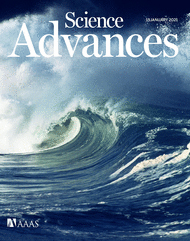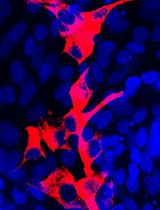- EN - English
- CN - 中文
Differentiation of Human Induced Pluripotent Stem Cell into Macrophages
人诱导多能干细胞向巨噬细胞的分化
发布: 2022年03月20日第12卷第6期 DOI: 10.21769/BioProtoc.4361 浏览次数: 4813
评审: Alka MehraAnthony FlamierAnonymous reviewer(s)

相关实验方案

人 iPSC 衍生神经元与少突胶质细胞共培养用于髓鞘形成的小分子筛选分析
Stefanie Elke Chie [...] Maria Consolata Miletta
2025年05月05日 3259 阅读

研究免疫调控血管功能的新实验方法:小鼠主动脉与T淋巴细胞或巨噬细胞的共培养
Taylor C. Kress [...] Eric J. Belin de Chantemèle
2025年09月05日 3445 阅读
Abstract
As a model to interrogate human macrophage biology, macrophages differentiated from human induced pluripotent stem cells (hiPSCs) transcend other existing models by circumventing the variability seen in human monocyte-derived macrophages, whilst epitomizing macrophage phenotypic and functional characteristics over those offered by macrophage-like cell lines (Mukherjee et al., 2018). Furthermore, hiPSCs are amenable to genetic manipulation, unlike human monocyte-derived macrophages (MDMs) (van Wilgenburg et al., 2013; Lopez-Yrigoyen et al., 2020), proposing boundless opportunities for specific disease modelling.
We outline an effective and efficient protocol that delivers a continual production of hiPSC-derived-macrophages (iMACs), exhibiting human macrophage surface and intracellular markers, together with functional activity.
The protocol describes the resuscitation, culture, and differentiation of hiPSC into mature terminal macrophages, via the initial and intermediate steps of expansion of hiPSCs, formation into embryoid bodies (EBs), and generation of hematopoietic myeloid precursors.
We offer a simplified, scalable, and adaptable technique that advances upon other protocols, utilizing feeder-free conditions and reduced growth factors, to produce high yields of consistent iMACs over a period of several months, economically.
Background
Macrophages occupy multiple tissues and orchestrate both innate and adaptive immune responses. Research into macrophage function and characterization has been impeded by multiple limitations suffered by model systems, such as human primary monocyte-derived macrophages (MDMs) and leukaemia-derived human macrophage-like cell lines (Hale et al., 2015; Alasoo et al., 2015; Mukherjee et al., 2018). The large volumes of blood required from donors presents ethical and logistical challenges, only exacerbated by the need for repeated venesection owing to the high variability observed within and between donors (van Wilgenburg et al., 2013). Human myeloid cell lines, such as THP-1, demonstrate karyotypical abnormalities and do not entirely represent human macrophages phenotypically or functionally (van Wilgenburg et al., 2013; Lopez-Yrigoyen et al., 2020, Baldassarre, et al., 2021).
Furthermore, human macrophages are typically resistant to genetic manipulation, hampering disease-specific modelling (Hale et al., 2015). Technology that employs human induced pluripotent stem cells (hiPSCs), boasting a self-renewing source of cells capable of differentiation into three germ layers, that are amenable to genetic manipulation, poses multiple attractive qualities as a model system over others (Alasoo et al., 2015; Lachmann et al., 2015; Alasoo et al., 2018; Lee et al., 2018, Nenasheva et al., 2020, Mukhopadhyay et al., 2020).
This protocol improves upon predecessors by the utilisation of feeder-free culture conditions with reduced requirements for growth factors, whilst still generating high yields of consistent terminally differentiated macrophages, which share phenotypical and functional characteristics to primary human MDMs. Millions of hiPSC-derived-macrophages (iMACs) can be conveniently harvested every 5–7 days from generated embryoid bodies (EBs) maintained in culture for several months. The protocol is easy to follow, cost-effective, and can be scaled to the user’s requirements, creating reproducible results for repeated experiments over time.
Materials and Reagents
Human induced Pluripotent Stem cells culture and expansion
Human induced Pluripotent Stem Cells used in the development of this protocol:
NL9—a fibroblast-derived hiPSC line from a healthy individual, which is widely available (Baghbaderani et al., 2016), obtained from the National Heart, Lung & Blood Institute (NHLBI) iPSC core (please see the Acknowledgments section for more information on the source of the NL9 hiPSC line)
KOLF_2—a skin tissue derived hiPSC line from a healthy individual, generated at the Sanger institute, as part of the HipSci initiative
Complete Essential 8 Basal Medium (Thermo Fisher, catalog number: A1517001)
Vitronectin (rhVTN-N) (Gibco, catalog number: A14700) 500 µg/mL
Dulbecco's phosphate-buffered saline (DPBS) without Ca2+/Mg2+ 500 mL (Thermo Fisher, catalog number: 14190144) (Storage conditions: 15–30°C. Shelf life: 36 months from date of manufacture)
ROCK inhibitor (ROCKi) (Y-27632 dihydrochloride) (Sigma, catalog number: Y0503-1MG)
10 cm or 6 well tissue culture treated plates (Corning, catalog number: 430167 or 3516)
0.22 µm filter steri-cups (Merck Millipore, catalog number: 15780319)
15 mL and 50 mL Falcon tubes (Falcon, catalog numbers: 352097 and 352098)
Embryoid body generation in a feeder-free system
0.5 M ultrapure Ethylenediaminetetraacetic acid (EDTA) (Invitrogen, catalog number: 15575020), 100 mL
Cryopreservation/freezing medium: KnockOut serum replacement (KSR) (Gibco, catalog number: 10828028), 500 mL
Dimethyl sulfoxide (DMSO) (Sigma, catalog number: D2438), 50 mL
Dulbecco's phosphate-buffered saline (DPBS) with Ca2+/Mg2+, 500 mL (Thermo Fisher, catalog number: 14040091) (Storage conditions: 2–8°C. Shelf life: 36 months from date of manufacture)
Bovine serum albumin (BSA) low endotoxin tissue culture-grade (Sigma, catalog number: A9543-5G)
Recombinant Human BMP-4 Protein 10 µg (R&D Systems, catalog number: 314-BP-010)
Embryoid Body Transfer, Culture and Macrophage Differentiation
Sterile water for embryo transfer (Sigma, catalog number: W1503)
Gelatin from porcine skin (Sigma, catalog number: G1890)
X-VIVO 15 Serum-free Hematopoietic Cell Medium 500 mL (Lonza, catalog number: LZBE02-060F)
L-Glutamine (200 mM), 100 mL (Gibco, catalog number: 25030181)
Penicillin-Streptomycin (10,000 U/mL), 100 mL (Gibco, catalog number: 15140122)
2-Mercaptoethanol (Sigma, catalog number: M3148)
Recombinant human M-CSF (Peprotech, catalog number: 300-25)
Recombinant human IL-3 (Peprotech, catalog number: 200-03)
RPMI 1640 Medium 500 mL (Sigma, catalog number: R0883)
Ultra-low adherent U bottom 96-well plates (Costar, catalog number: 7007)
10 cm tissue culture dishes or 6-well plates
70-100 µm cell strainers (Falcon)
Complete Essential 8 Basal Medium (see Recipes)
Vitronectin 1 mL vial (see Recipes)
ROCK inhibitor (ROCKi) (see Recipes)
0.5 mM Ethylenediaminetetraacetic acid (EDTA) solution (see Recipes)
Cryopreservation/freezing Medium (see Recipes)
Bovine serum slbumin (BSA) (see Recipes)
Recombinant Human BMP-4 Protein (see Recipes)
Sterile water for embryo transfer (see Recipes)
Gelatin from porcine skin (see Recipes)
EB-Myeloid precursor base medium (see Recipes)
Recombinant Human M-CSF (see Recipes)
Recombinant Human IL-3 (see Recipes)
Macrophage Differentiation base medium (see Recipes)
Flow Cytometry Antibodies used in this protocol
CD14 (BV605, Biolegend, catalogue number: 301834)
CD16 (APC, eBioscience, catalogue number: 17-0168-42)
CD80 (BV711, Biolegend, catalogue number: 305236)
CD86 (PE-Dazzle594, Biolegend, catalogue number: 374217)
CD206 (PerCP/Cyanine 5.5, Biolegend, Catelogue number: 321122)
CD204 (PE/Cyanine7 Biolegend, catalogue number: 371908)
Primer sequences used in this protocol
TATA-Binding Protein (TBP) (F: GGGAAGGGGCATTATTTG, R: CCAGATAGCAGCACGGTA).
CD68 (F: GGAAATGCCACGGTTCATCCA, R: TGGGGTTCAGTACAGAGATGC)
CSFR1 (F: TCCAACATGCCGGCAACTA, R: GCTCAAGTTCAAGTAGGCACTCTCT)
CD163 (F: TTTGTCAACTTGAGTCCCTTCAC, R: TCCCGCTACACTTGTTTTCAC)
SOX2 F: GCTACAGCATGATGCAGGACCA, R: TCTGCGAGCTGGTCATGGAGTT)
NANOG (F: CTCCAACATCCTGAACCTCAGC, R: CGTCACACCATTGCTATTCTTCG)
OCT4 (F: CCTGAAGCAGAAGAGGATCACC, R: AAAGCGGCAGATGGTCGTTTGG)
Equipment
Class 2 microbiological safety hood or cabinet using an aseptic technique
37°C incubator with 5% CO2
Centrifuge
Phase-contrast microscope (4×, 10×, 40× magnification)
Water bath set at 37°C
-80°C storage
Liquid Nitrogen storage
Cell freezing containers (“Mr Frosty”)
Pipette controller and selection of different volume stripettes (5 mL, 10 mL), which usually have large-bore orifices
Pipettes (P1000, P200, P20, P2) and corresponding sterile tips.
ParafilmTM
Procedure
文章信息
版权信息
© 2022 The Authors; exclusive licensee Bio-protocol LLC.
如何引用
Readers should cite both the Bio-protocol article and the original research article where this protocol was used:
- Douthwaite, H., Arteagabeitia, A. B. and Mukhopadhyay, S. (2022). Differentiation of Human Induced Pluripotent Stem Cell into Macrophages. Bio-protocol 12(6): e4361. DOI: 10.21769/BioProtoc.4361.
- Baldassarre, M., Solano-Collado, V., Balci, A., Colamarino, R. A., Dambuza, I. M., Reid, D. M., Wilson, H. M., Brown, G. D., Mukhopadhyay, S., Dougan, G. et al. (2021). The Rab32/BLOC-3-dependent pathway mediates host defense against different pathogens in human macrophages. Sci Adv 7(3): eabb1795.
分类
免疫学 > 免疫细胞功能 > 巨噬细胞
干细胞 > 多能干细胞 > 细胞分化
细胞生物学 > 细胞分离和培养 > 细胞分化
您对这篇实验方法有问题吗?
在此处发布您的问题,我们将邀请本文作者来回答。同时,我们会将您的问题发布到Bio-protocol Exchange,以便寻求社区成员的帮助。
Share
Bluesky
X
Copy link










